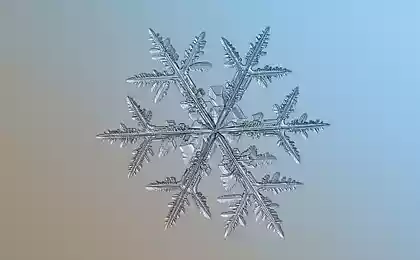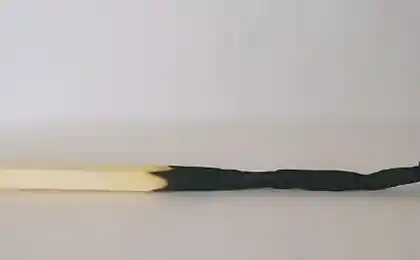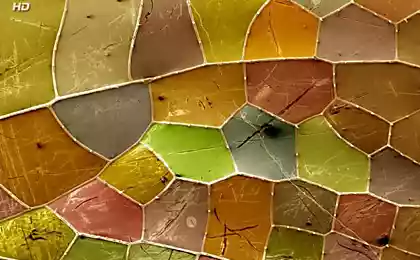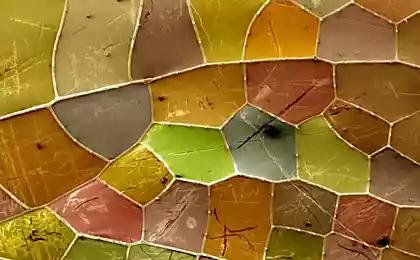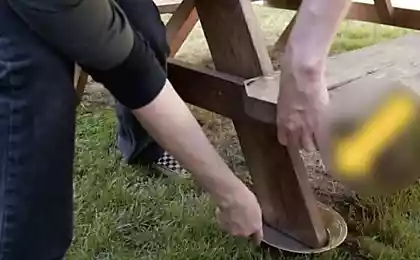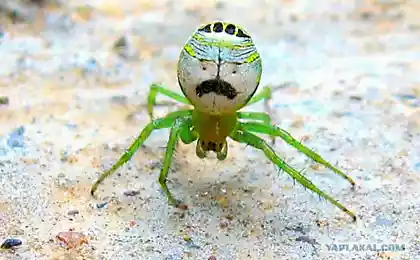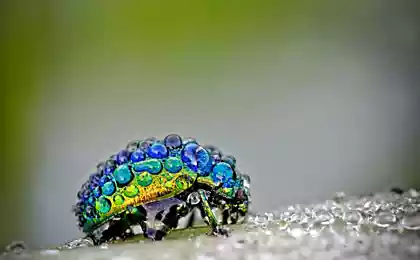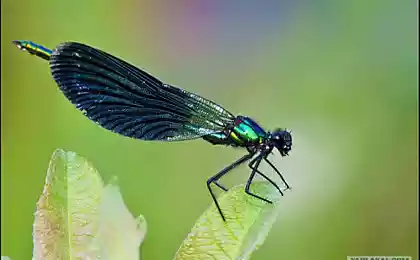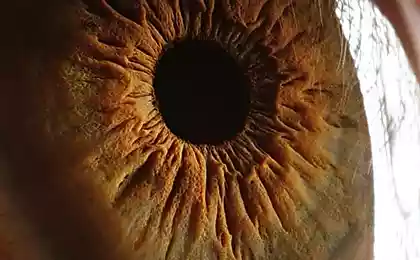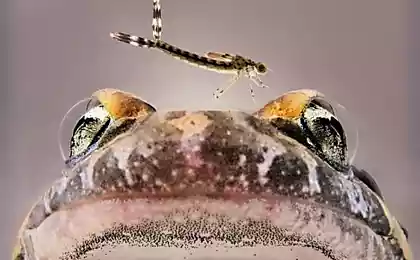1095
Insects - Macro for PL
I am fond of photography of insects. I wanted to show the beauty of YaPovtsam macrocosm and help pass workdays. ZY Strongly please do not kick as "I'm not a magician - I'm just learning»
The collection of 10 images will let down, do not break pl3.
I'll start with the largest butterflies in my collection, and I think everybody already familiar.
# 1 Swallowtail (Papilio machaon)
Wingspan 64-81 mm in males, females - 74-95 mm. The main background color of the wings - intense yellow. The front wings with black spots and veins, and with a wide black border with a yellow crescent-shaped spots on the outer edge of the wing. Hind wings have "tails" of up to 10 mm Coating rear wings with blue and yellow spots, red-brown eye, surrounded by black, is located in the corner of the wing.

# 2 Golden chafer (Cetonia aurata) Germans call these insects "rozenkefer," which also means "beetle Rose" and "Pink beetle." It is interesting that both values are valid, because among bronzovok often there are individuals with a reddish shell.
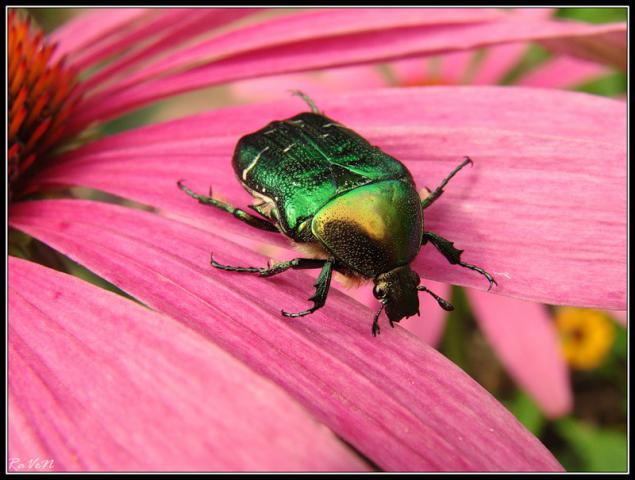
Middle Eastern chafer golden reaches a length of 20 mm. Elytra green with metallic sheen and narrow transverse white patterns. Bottom body beetle bronze color with purple highlights. The larvae are white with a yellow-brown head with short sparse hairs. The larva is very gluttonous. It grows quickly and in a month after hatching has already reached half of its final value. In one month, the larva eats the food in several thousand times greater than the volume of his body.
Chafer larva eats constantly and turns into a powder already ruined rotting dead leaves and stems. The larva eats slowly, strong jaws, separating them into fibers, and then gnaws. In her gut, they are transformed into the dough, it is suitable for fertilizing the soil. One of the most active producers of black soil - chafer larvae.
Chafer larvae noteworthy for another reason. It is thick, two to three centimeters in length, arched and flat on his back on the ventral side. Its dorsal side in deep folds. The feet are small, weak, and does not correspond with the size of the body. Larvae can roll ring. This situation of self-defense in case of alarm. If the striker left alone, she turns and crawls. Laid on the table a larva crawling on his back, holding his legs in the air. This is the usual way to move chafer larvae. # 3 chafer climbs. The picture is a bit blurry, time enough to fast, despite her obesity.
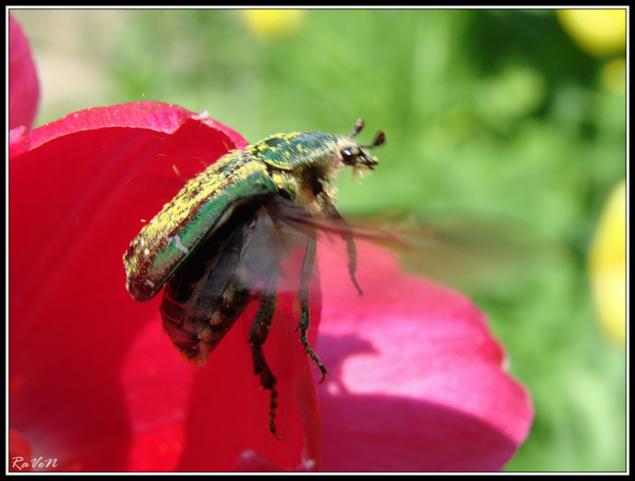
# 4 Male dragonflies flat (Libellula depressa)
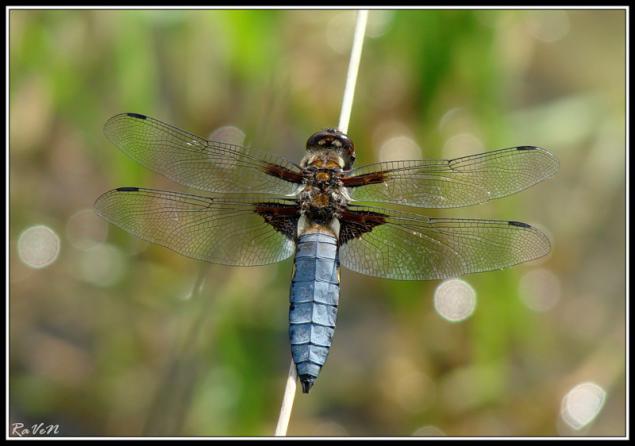
Markedly different from other species of dragonflies, the length of the wings has 33-37 mm, a length of the abdomen - 22-28 mm. Abdomen greatly flattened and expanded. At the base of the wing there is a large dark brown spots, the rest of the wing membrane is transparent. Males and females differ in color abdomen: the male is on top painted in bright blue (usually bright blue) color, and females honey-brown. # 5 Brown Hawker (Aeshna grandis), male
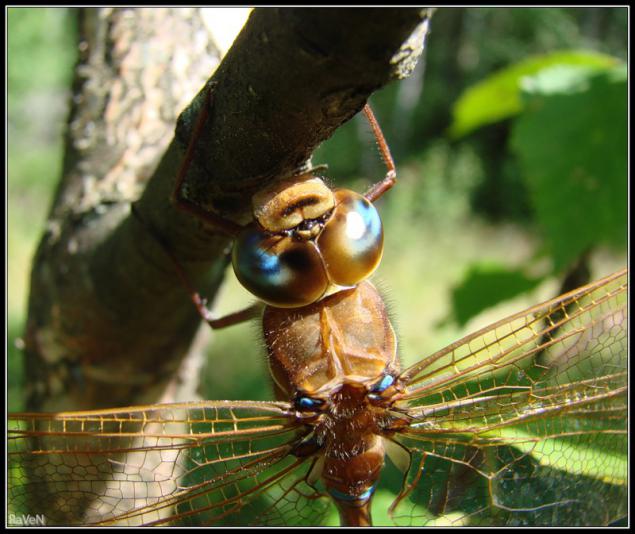
They live along the banks of ponds, in good weather, they can always be seen above the water. The body length of 7 - 8 cm, 10 cm wingspan.
Female without blue spots on the abdomen. In summer seize their prey: flies, mosquitoes, moths.
They mate in flight, forming a marriage ring. # 6 common blue (Polyommatus icarus)
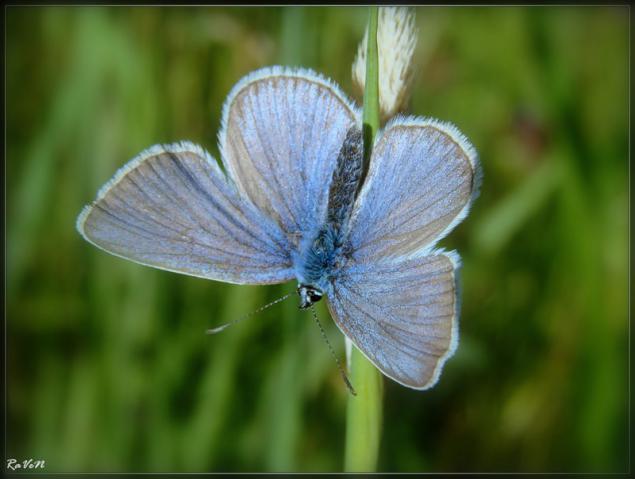
Common blue (Polyommatus icarus) - view from widespread. Males sky blue, females brown with orange spots crescent on the edge of the rear wings. Bottom rear wing submarginal orange spots are well developed, at the root of the front wing, a dark dot. The caterpillars live on beans and Rosaceae. # 7 Racehorse field (Cicindela campestris)
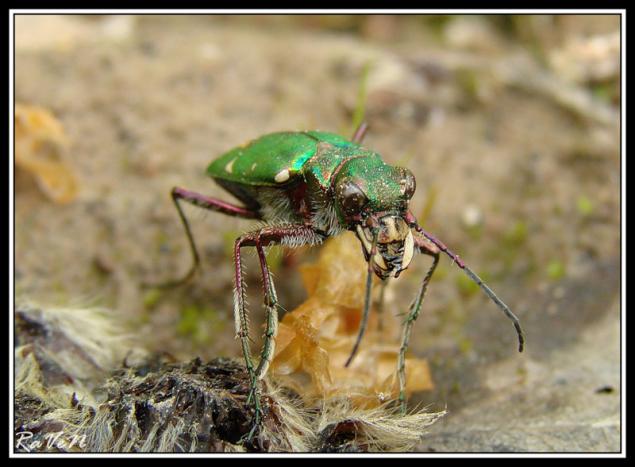
Racehorse field (Cicindela campestris) This sun-loving beetle is constantly running - he is looking for small insects that feed. When the danger of taking off with a characteristic buzzing sound. Picture of yellow spots on the elytra volatile themselves elytra may be darker than the beetle shown in the picture. Edge elytron copper, and sometimes purple. Larvae - extremely entertaining creatures - they are white, their head is large and covered with a horny substance. The eighth segment of the body has a cone-shaped elevation on the lower side of which are the pair of sharpened hooks. These larvae live in burrows vertical (approximately 20 cm depth) and run past catch insects. She never comes out from his hiding place, but only puts it out of its large crescent-shaped mandibles. For pupation digs deeper. The length of adult specimens of 10-15 mm, live all over Europe, are not uncommon in Russia. # 8 Caterpillar Strelchatki maple (Acronicta aceris)

Strelchatka maple (Acronicta aceris) distributed in Eurasia, the Mediterranean, Russia - in the mixed forests and steppe zones of European part, the Caucasus, in the mountains of Central Asia.
The wings span up to 45 mm. Generation odnogodovaya (in the north) or double (in the south). Flight in May and June. Eggs are laid singly on the underside of the leaves of maple and other trees.
Track up to 5 cm, hatch in June and July, beginning skeletonizing leaves, and then devour them almost completely, leaving only the midrib. Pupation in the dense gray cocoon in cracks in the bark at the bottom of the trunk or on the forest floor, where the pupae overwinter.
Maple strelchatka sometimes breeds in large numbers and different types of damages maple, horse chestnut, less oak, beech, elm, poplar, linden, willow, walnut, mulberry, fruit in young plantings, parks, nurseries. # 9 Krepkogolovka Palemon (Carterocephalus palaemon)
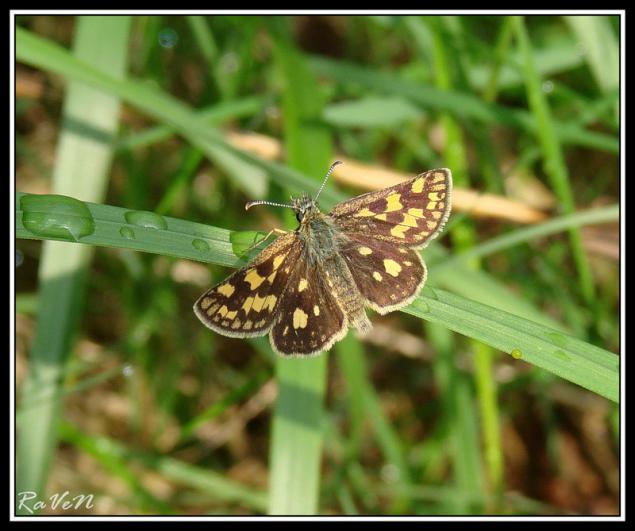
The length of the front wings up to 1.5 cm.
On a dark brown background scattered series of orange-yellow spots of various sizes. The female is more gray than male, with yellow spots. Highland items smaller and darker in color (known as Form freyi Hellw). Butterfly flies quickly and easily, preferring to stay close to the ground. # 10 gonepteryx (Gonepteryx rhamni)

Gonepteryx (Gonepteryx rhamni) caterpillars that develop on buckthorn. In this male butterfly lemon-yellow and greenish-white female; in the middle of each wing has a red dot; scope - 5-beige.
Source:
The collection of 10 images will let down, do not break pl3.
I'll start with the largest butterflies in my collection, and I think everybody already familiar.
# 1 Swallowtail (Papilio machaon)
Wingspan 64-81 mm in males, females - 74-95 mm. The main background color of the wings - intense yellow. The front wings with black spots and veins, and with a wide black border with a yellow crescent-shaped spots on the outer edge of the wing. Hind wings have "tails" of up to 10 mm Coating rear wings with blue and yellow spots, red-brown eye, surrounded by black, is located in the corner of the wing.

# 2 Golden chafer (Cetonia aurata) Germans call these insects "rozenkefer," which also means "beetle Rose" and "Pink beetle." It is interesting that both values are valid, because among bronzovok often there are individuals with a reddish shell.

Middle Eastern chafer golden reaches a length of 20 mm. Elytra green with metallic sheen and narrow transverse white patterns. Bottom body beetle bronze color with purple highlights. The larvae are white with a yellow-brown head with short sparse hairs. The larva is very gluttonous. It grows quickly and in a month after hatching has already reached half of its final value. In one month, the larva eats the food in several thousand times greater than the volume of his body.
Chafer larva eats constantly and turns into a powder already ruined rotting dead leaves and stems. The larva eats slowly, strong jaws, separating them into fibers, and then gnaws. In her gut, they are transformed into the dough, it is suitable for fertilizing the soil. One of the most active producers of black soil - chafer larvae.
Chafer larvae noteworthy for another reason. It is thick, two to three centimeters in length, arched and flat on his back on the ventral side. Its dorsal side in deep folds. The feet are small, weak, and does not correspond with the size of the body. Larvae can roll ring. This situation of self-defense in case of alarm. If the striker left alone, she turns and crawls. Laid on the table a larva crawling on his back, holding his legs in the air. This is the usual way to move chafer larvae. # 3 chafer climbs. The picture is a bit blurry, time enough to fast, despite her obesity.

# 4 Male dragonflies flat (Libellula depressa)

Markedly different from other species of dragonflies, the length of the wings has 33-37 mm, a length of the abdomen - 22-28 mm. Abdomen greatly flattened and expanded. At the base of the wing there is a large dark brown spots, the rest of the wing membrane is transparent. Males and females differ in color abdomen: the male is on top painted in bright blue (usually bright blue) color, and females honey-brown. # 5 Brown Hawker (Aeshna grandis), male

They live along the banks of ponds, in good weather, they can always be seen above the water. The body length of 7 - 8 cm, 10 cm wingspan.
Female without blue spots on the abdomen. In summer seize their prey: flies, mosquitoes, moths.
They mate in flight, forming a marriage ring. # 6 common blue (Polyommatus icarus)

Common blue (Polyommatus icarus) - view from widespread. Males sky blue, females brown with orange spots crescent on the edge of the rear wings. Bottom rear wing submarginal orange spots are well developed, at the root of the front wing, a dark dot. The caterpillars live on beans and Rosaceae. # 7 Racehorse field (Cicindela campestris)

Racehorse field (Cicindela campestris) This sun-loving beetle is constantly running - he is looking for small insects that feed. When the danger of taking off with a characteristic buzzing sound. Picture of yellow spots on the elytra volatile themselves elytra may be darker than the beetle shown in the picture. Edge elytron copper, and sometimes purple. Larvae - extremely entertaining creatures - they are white, their head is large and covered with a horny substance. The eighth segment of the body has a cone-shaped elevation on the lower side of which are the pair of sharpened hooks. These larvae live in burrows vertical (approximately 20 cm depth) and run past catch insects. She never comes out from his hiding place, but only puts it out of its large crescent-shaped mandibles. For pupation digs deeper. The length of adult specimens of 10-15 mm, live all over Europe, are not uncommon in Russia. # 8 Caterpillar Strelchatki maple (Acronicta aceris)

Strelchatka maple (Acronicta aceris) distributed in Eurasia, the Mediterranean, Russia - in the mixed forests and steppe zones of European part, the Caucasus, in the mountains of Central Asia.
The wings span up to 45 mm. Generation odnogodovaya (in the north) or double (in the south). Flight in May and June. Eggs are laid singly on the underside of the leaves of maple and other trees.
Track up to 5 cm, hatch in June and July, beginning skeletonizing leaves, and then devour them almost completely, leaving only the midrib. Pupation in the dense gray cocoon in cracks in the bark at the bottom of the trunk or on the forest floor, where the pupae overwinter.
Maple strelchatka sometimes breeds in large numbers and different types of damages maple, horse chestnut, less oak, beech, elm, poplar, linden, willow, walnut, mulberry, fruit in young plantings, parks, nurseries. # 9 Krepkogolovka Palemon (Carterocephalus palaemon)

The length of the front wings up to 1.5 cm.
On a dark brown background scattered series of orange-yellow spots of various sizes. The female is more gray than male, with yellow spots. Highland items smaller and darker in color (known as Form freyi Hellw). Butterfly flies quickly and easily, preferring to stay close to the ground. # 10 gonepteryx (Gonepteryx rhamni)

Gonepteryx (Gonepteryx rhamni) caterpillars that develop on buckthorn. In this male butterfly lemon-yellow and greenish-white female; in the middle of each wing has a red dot; scope - 5-beige.
Source:


